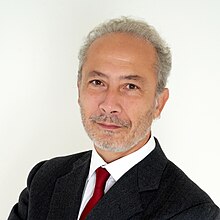Giuseppe Di Giovanni
 From Wikipedia - Reading time: 5 min
From Wikipedia - Reading time: 5 min

Giuseppe Di Giovanni, Cavaliere (born May 24, 1968; Palermo, Italy) is a Professor of Human Physiology and Neuroscience at the Magna Græcia University of Catanzaro, Italy.
Early life
[edit]Di Giovanni Giuseppe received his PhD in Neuroscience from the University of Chieti, Italy and was a postdoctoral fellow at Yale University, CT, USA.
Career
[edit]He served as a Senior Lecturer of Human Physiology at the Faculty of Medicine and Surgery, University of Palermo. Later he became Professor of Human Physiology and Neuroscience at the University of Malta, as well as an Honorary Professor at the Neuroscience Division of the School Biosciences at Cardiff University, UK.[1] He is also an Adjunct Professor at Korea University, School of Medicine in Korea, Seoul. He is currentely a Full Professor of Human Physiology at the Medical School of the Magna Græcia University, Catanzaro, Italy. His main research interests are in experimental neurology and biological psychiatry. Specifically, he is interested in the pathophysiological role of cannabinoids and serotonin, and especially of the 5-HT2C receptors, in brain disorders, such as epilepsy, depression, drugs of abuse and Parkinson's disease. He has published more than 160 articles in top biomedical journals including Nature Medicine and Nature Neuroscience, 15 books and several journal special issues. [2][3][4][5][6][7][8][9] He is the Past-President of the "Mediterranean Neuroscience Society (MNS) the President of the Malta Physiological Society and the Treasurer of the Malta Neuroscience Network. He is the Editor-in-Chief of the prestigious Journal of Neuroscience Methods by Elsevier, Amsterdam, Netherlands and the Editor of the book series "The Receptors" by Springer, USA and serves as associate editor for the CNS Neuroscience & Therapeutics by Wiley. On 28 May 2020 he was awarded the honour of Cavaliere (Knight) of the Order of the Star of Italy by the President of the Italian Republic Sergio Mattarella. He was listed among the World’s Top 2% Scientists ranking for his work in 2019[10] and 2020[11] in the field of Neuroscience. In 2022, he was elected a member of Academia Europaea,[12] due to his achievements in Physiology and Neuroscience research and Secretary-General of IBRO, the International Brain Research Organization, for the term January 2023 – December 2025.
References
[edit]- ^ "Professor Giuseppe Di Giovanni - People - Cardiff University". Cardiff University. Retrieved 1 November 2018.
- ^ Di Giovanni G, De Deurwaerdère P. New therapeutic opportunities for 5-HT2C receptor ligands in neuropsychiatric disorders. Pharmacol Ther. 2016 Jan;157:125-62. doi: 10.1016/j.pharmthera.2015.11.009.
- ^ Delicata F, Bombardi C, Pierucci M, Di Maio R, De Deurwaerdère P, Di Giovanni G. Preferential modulation of the lateral habenula activity by serotonin-2A rather than -2C receptors: Electrophysiological and neuroanatomical evidence. CNS Neurosci Ther. 2018 Aug;24(8):721-733.
- ^ Venzi M, David F, Bellet J, Cavaccini A, Bombardi C, Crunelli V, Di Giovanni G. Role for serotonin2A (5-HT2A) and 2C (5-HT2C) receptors in experimental absence seizures. Neuropharmacology. 2016 Sep;108:292-304. doi: 10.1016/j.neuropharm.2016.04.016.
- ^ De Deurwaerdère P, Di Giovanni G. Serotonergic modulation of the activity of mesencephalic dopaminergic systems: Therapeutic implications. Prog Neurobiol. 2017 Apr;151:175-236. doi: 10.1016/j.pneurobio.2016.03.004.
- ^ Di Giovanni G, Crunelli V, Rizzolatti G. Interdisciplinary approaches for neuropathology. CNS Neurosci Ther. 2018 Aug;24(8):665-668. doi: 10.1111/cns.13004.
- ^ Di Giovanni G, De Deurwaerdére P, Di Mascio M, Di Matteo V, Esposito E, Spampinato U. Selective blockade of serotonin-2C/2B receptors enhances mesolimbic and mesostriatal dopaminergic function: a combined in vivo electrophysiological and microdialysis study. Neuroscience. 1999;91(2):587-97.
- ^ Mccafferty C, David F, Venzi M, Orban G, Lambert Rc, Leresche N, Di Giovanni G, Crunelli V. (2018) Contrasting firing dynamics of thalamic neuron ensembles suggest a new pathophysiology of absence seizures. Nature Neuroscience; 21(5):744-756.
- ^ Cope D.W., Di Giovanni G., Orban G., Fyson S.J., Errington A.C., Lorincz M.L., Gould T.M., Carter D.A., Crunelli V. (2009) Enhanced tonic GABAA inhibition is required in typical absence epilepsy. Nature Medicine; 15(12), 1392-1398.
- ^ Baas, Jeroen; Boyack, Kevin; Ioannidis, John P.A. (2020), "Data for "Updated science-wide author databases of standardized citation indicators"", Mendeley Data, V2, doi: 10.17632/btchxktzyw.2
- ^ Baas, Jeroen; Boyack, Kevin; Ioannidis, John P.A. (2021), "August 2021 data-update for "Updated science-wide author databases of standardized citation indicators"", Mendeley Data, V3, doi: 10.17632/btchxktzyw.3
- ^ "Giuseppe Di Giovanni". Member. Academia Europaea. Retrieved 13 September 2024.
External links
[edit]- Giuseppe Di Giovanni publications indexed by Google Scholar
 KSF
KSF